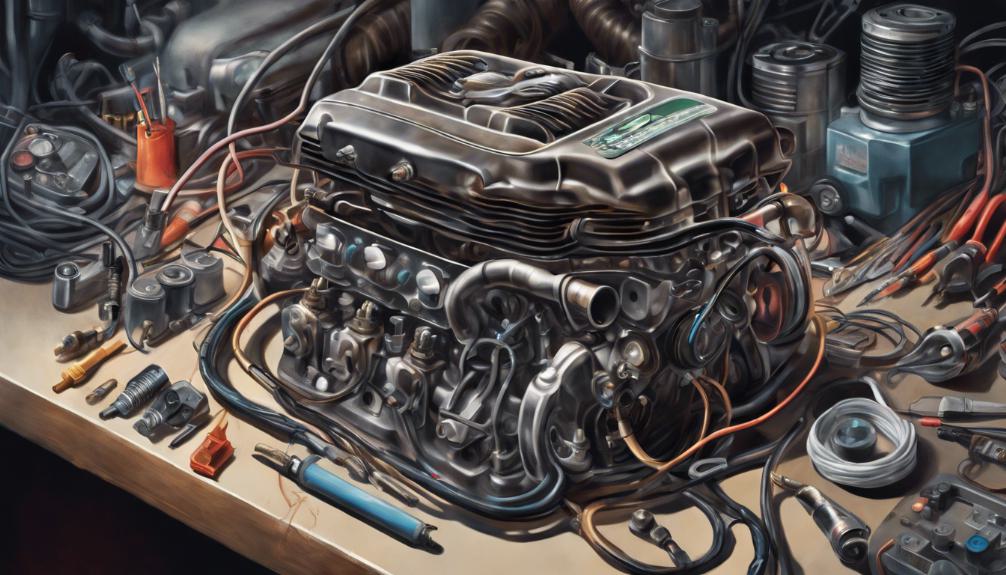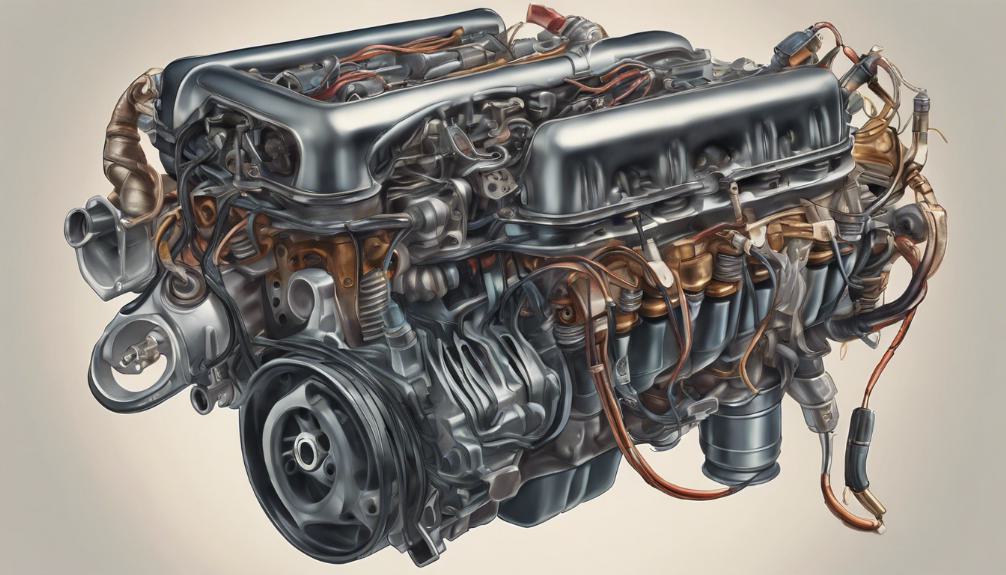If you’re dealing with the P2305 trouble code, addressing ignition coil B secondary circuit issues is vital. Begin by checking primary control wires for damage.
Perform voltage tests to guarantee proper flow. Measure ignition coil B resistance accurately. Confirm secure ground connections.
Examine system components for wear. Thoroughly inspect the secondary circuit and conduct coil resistance testing for diagnosis. Make sure all wiring connections are intact and free of damage.
Follow manufacturer repair guidelines precisely. Proper maintenance prevents code recurrence. Further insight into troubleshooting these issues awaits.
What You Need to Know
- Start with voltage checks on ignition coil B.
- Test coil resistance with a digital volt-ohm meter.
- Inspect wiring harness for damage or loose connections.
- Verify proper grounding of the ignition coil.
- Follow manufacturer’s guidelines for repair and maintenance.
P2305 Code Overview

If you’re experiencing the P2305 trouble code, you’re likely facing a fault in the ignition coil B secondary circuit. Ignition coil testing is vital to diagnose this issue accurately.
To start, perform voltage checks on the ignition coil to make sure it’s receiving the proper electrical supply. Use a multimeter to measure the voltage and compare it to the manufacturer’s specifications.
If the voltage is outside the recommended range, it could indicate a problem with the ignition coil or its circuit.
For effective ignition coil testing, make sure to inspect the wiring harness connected to the ignition coil for any signs of damage or corrosion. A faulty electrical connection can also trigger the P2305 trouble code.
By conducting thorough voltage checks and examining the wiring, you can pinpoint the source of the issue and take appropriate measures to resolve it.
Symptoms of Ignition Coil B Issues
Experiencing engine misfires and reduced performance are common indicators of potential issues with Ignition Coil B. If you suspect problems with this component, it’s essential to understand the symptoms associated with it.
Here are some key signs to look out for:
- Engine misfires: Ignition Coil B problems often manifest as engine misfires, where the engine hesitates or stutters during acceleration.
- Reduced performance: A decrease in overall engine performance, such as sluggish acceleration or difficulty maintaining speed, can be attributed to issues with Ignition Coil B.
- Diagnostic process: To pinpoint Ignition Coil B issues, a diagnostic process involving scanning for trouble codes and testing coil resistance is important.
- Testing: Proper testing methods, including swapping coils to isolate the problem, can help determine the specific issue related to Ignition Coil B.
Common Causes of P2305 Code

Common causes of the P2305 trouble code include issues with the ignition coil B secondary circuit, such as a bad spark plug wire or boot.
When troubleshooting ignition coil problems, it’s crucial to take into account secondary circuit diagnostics.
Malfunctions like a faulty relay or blown fuse can lead to the P2305 error. Open or shorted wiring, as well as faulty wiring connectors, are also common triggers for the P2305 trouble code.
Then, a defective ignition coil can be a prevalent cause of the P2305 code.
Problems with the camshaft or crankshaft sensor, along with any associated wiring issues, can result in the P2305 error.
To effectively address the P2305 code, a thorough examination of the ignition coil’s secondary circuit and related components is necessary.
Troubleshooting Steps for P2305
To address potential ignition coil B secondary circuit issues indicated by the P2305 trouble code, begin by checking the primary control wires for rub through or short. Here are some troubleshooting steps:
- Perform voltage testing to validate proper electrical flow within the system.
- Conduct resistance measurement on the ignition coil B to assess its functionality accurately.
- Verify the ground connection to rule out any grounding issues that could affect the ignition system.
- Inspect the ignition system components for any signs of wear or damage that may be contributing to the problem.
Diagnostic Process for Coil B Circuit

Begin by thoroughly examining the ignition coil B secondary circuit to pinpoint any potential issues affecting its performance.
Start by conducting coil resistance testing to assess the condition of the ignition coil. Use a multimeter to measure the resistance and compare it to the manufacturer’s specifications.
Confirm the wiring connections are securely in place and free of any damage or corrosion. Check for proper routing of the wires, paying attention to any signs of wear or fraying.
Take security precautions when working with electrical components to prevent any accidents.
If any faults are detected during the testing process, troubleshoot by inspecting the connections for loose fittings or breaks.
Address any issues found promptly to prevent further damage to the ignition coil B circuit. Remember that proper maintenance and care of the ignition system can help prevent the recurrence of the P2305 trouble code.
If necessary, consider replacing the faulty ignition coil B to resolve the issue effectively.
Repair Solutions for P2305 Code
For resolving the P2305 trouble code related to ignition coil B secondary circuit issues, consider inspecting and addressing any faulty components promptly. Here are some repair solutions to help you tackle the P2305 code effectively:
- Coil Testing Methods: Use a digital volt-ohm meter (DVOM) to test the resistance of the ignition coil. Compare the readings to the manufacturer’s specifications to determine if the coil is faulty.
- Wiring Inspection Tips: Thoroughly inspect the wiring harness connecting the ignition coil to the vehicle’s electrical system.
Look for any signs of damage, corrosion, or loose connections that could be causing the P2305 trouble code.
- Check for Grounding Issues: Confirm that the ignition coil is properly grounded to the vehicle’s chassis. Poor grounding can lead to erratic behavior and trigger the P2305 trouble code.
- Consult Manufacturer Guidelines: Follow the repair and replacement procedures recommended by the vehicle manufacturer. Adhering to these guidelines will help you address the P2305 code accurately and prevent future issues.
As an Amazon Associate we earn from qualifying purchases.










